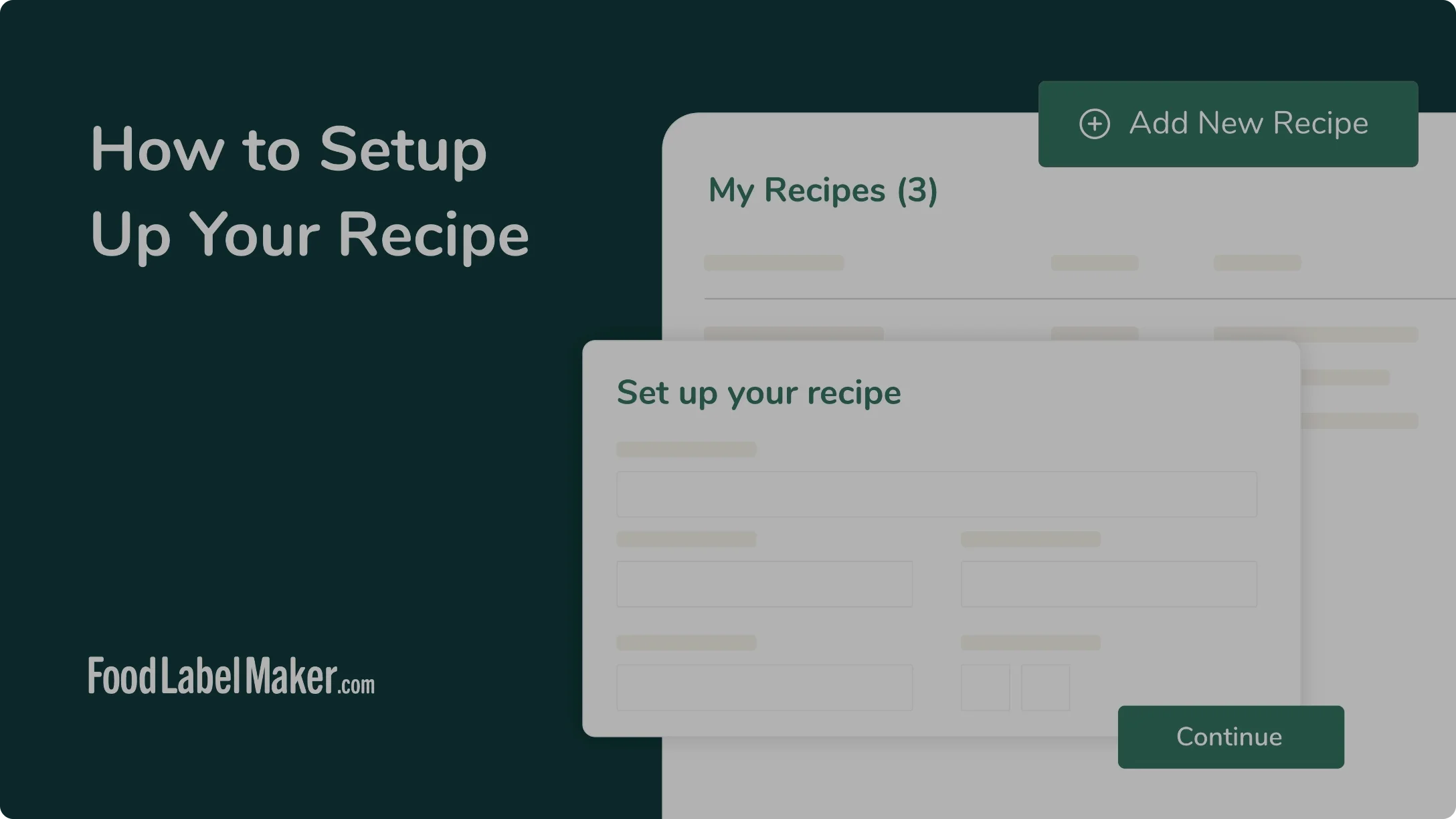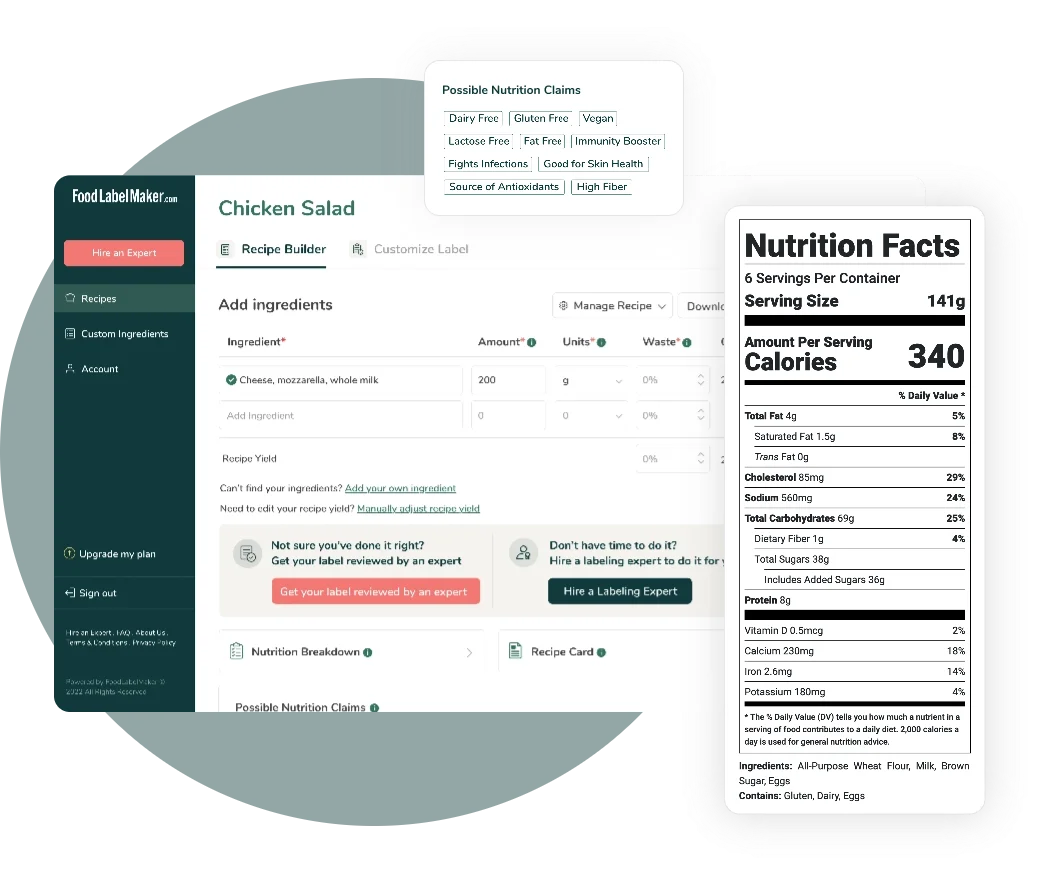
Easy and Compliant Nutrition Label Software
Developed by certified nutritionists, Food Label Maker provides user-friendly software that generates 100% regulatory-compliant nutrition facts labels.
We offer:
- Accurate nutrition analysis
- Customizable label formats and features
- Comprehensive menu and recipe management
- World-class customer support
Our Features
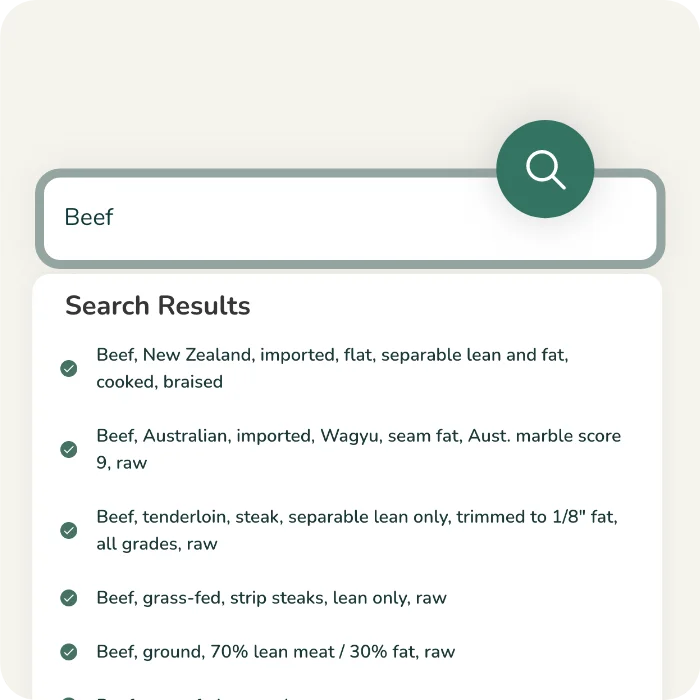
Verified Ingredient Database
Access our continuously expanding ingredient database with more than 10,000+ ingredients, meticulously reviewed and updated by our team of nutritionists.
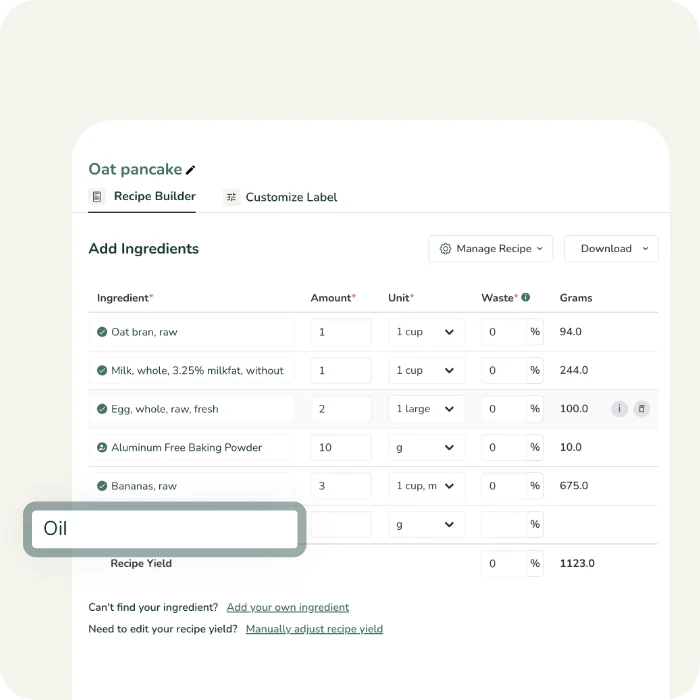
Simple Recipe Builder
Our user-friendly recipe builder helps you quickly search and add ingredients to your recipe.
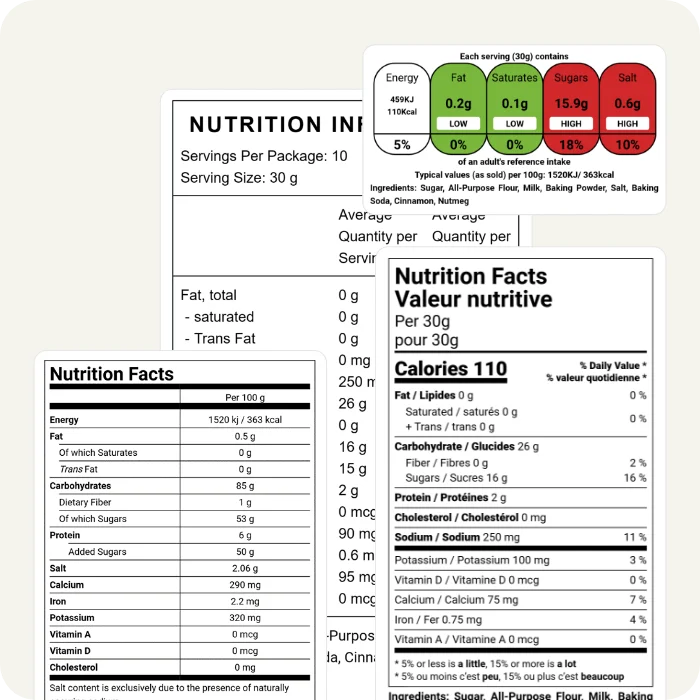
Market-Compliant Labels
Built on the latest regulatory guidelines released by the FDA in the US, the CFIA in Canada, the COFEPRIS in Mexico, the FSA in the UK, the DG SANTE in the EU, and the FSANZ in Australia & New Zealand.
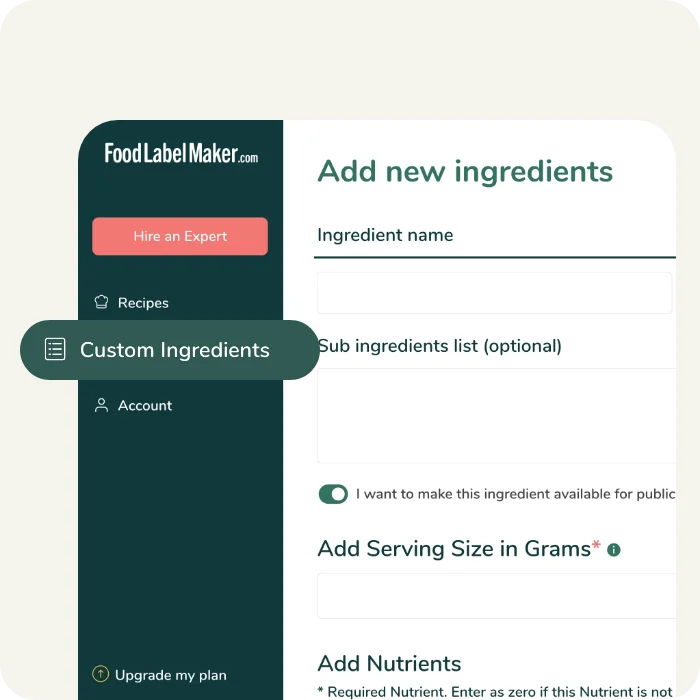
Add Custom Ingredients
Add custom ingredients seamlessly to your account, and use them in any of your recipes.
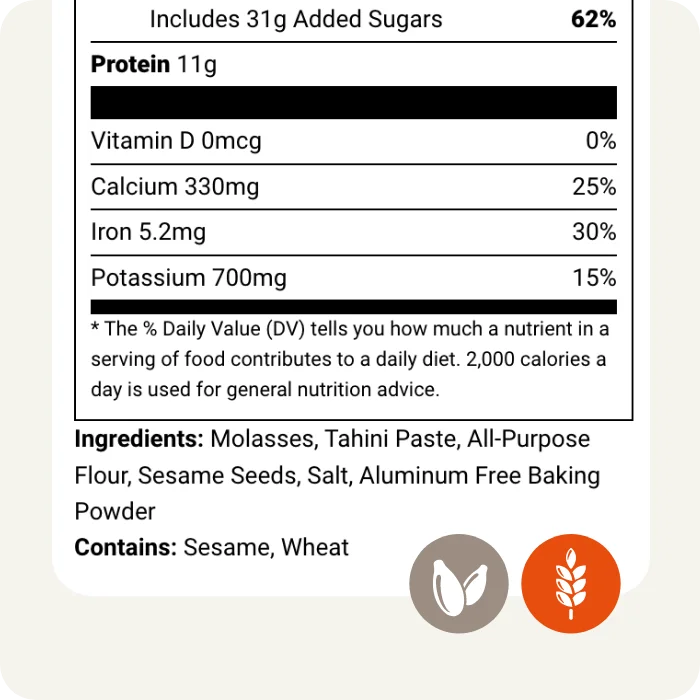
Automated Allergen Detection
Our integrated allergen scanning feature analyzes your recipe and automatically detects the allergens that must be declared on your product label.
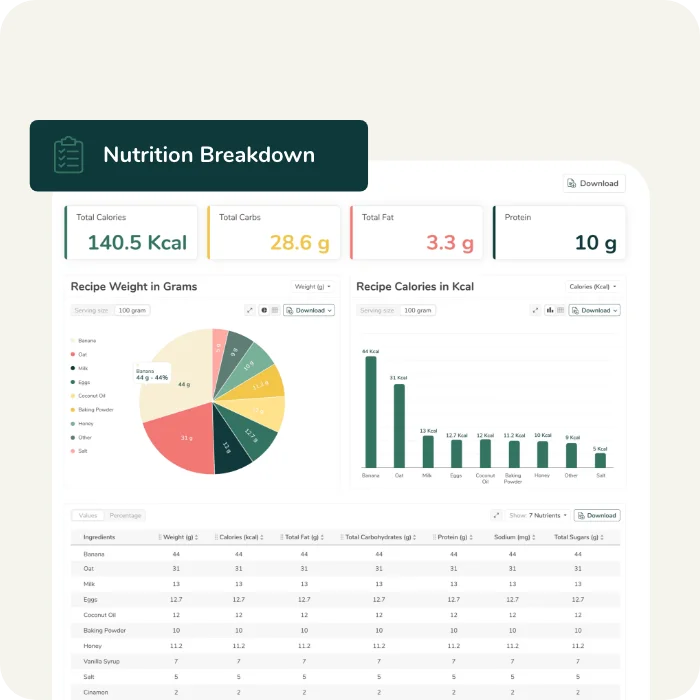
Detailed Nutrition Breakdown
Get in-depth analysis of your recipe’s nutrients, vitamins, & minerals. Identify which ingredients are driving each nutrient, and make informed decisions on how to optimize your recipe.
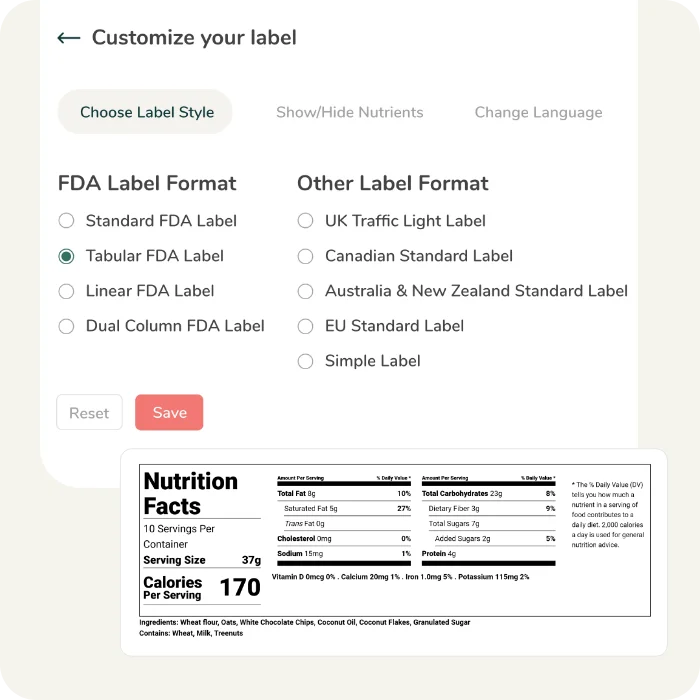
Multiple Label Styles & Formats
Choose from over 10 different label formats including Vertical, Tabular, Linear, Dual Column, Bilingual, Simple, and Traffic Light labels.
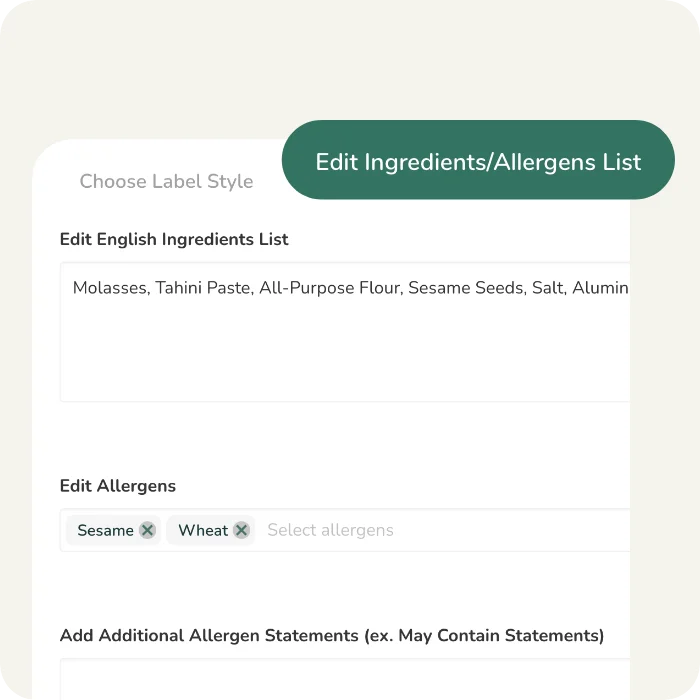
Editable Ingredient statement
Manually edit your ingredients or allergen statements to show your customers exactly what you would like to show them.
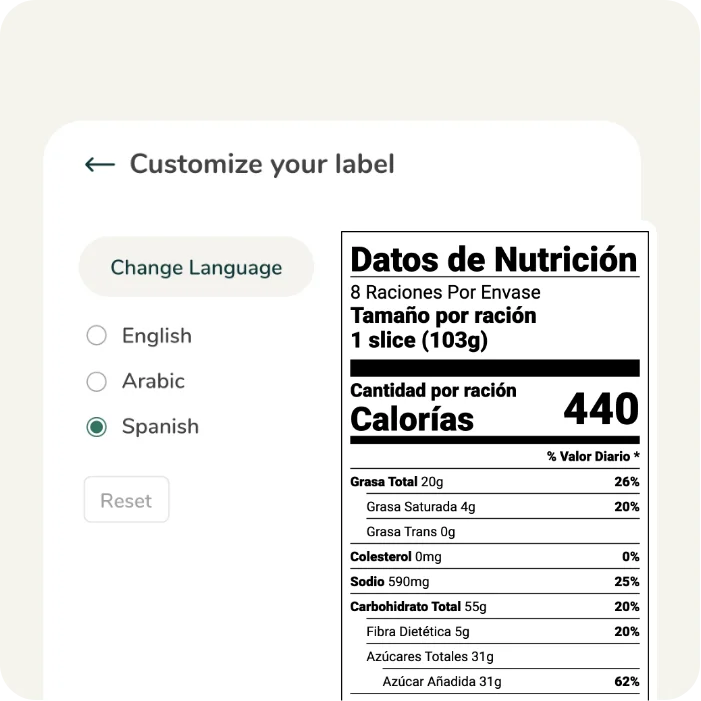
Built-In Language Translation
Get your labels translated to any of our supported languages (Spanish, French, Arabic & More) with one click.
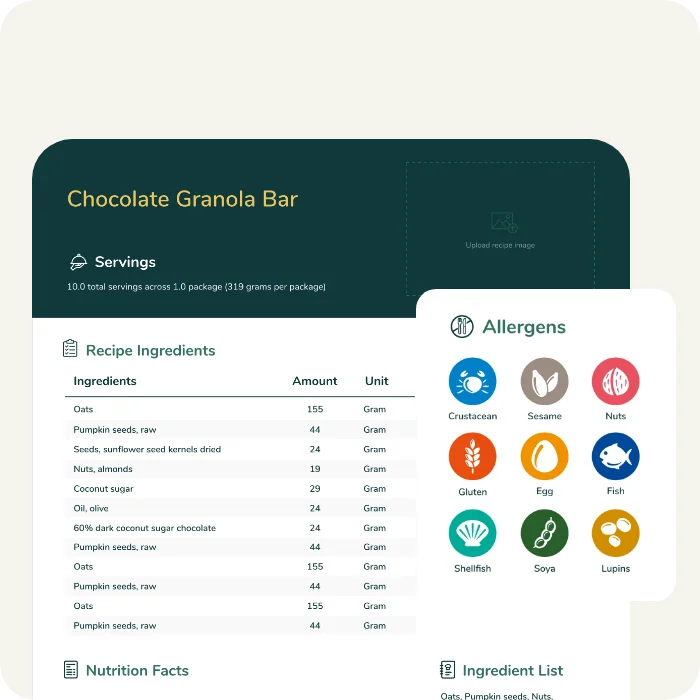
Comprehensive Recipe Cards
Generate and print comprehensive recipe cards showcasing your ingredients, nutrition facts, allergens, cooking instructions, and a visual representation of the dish.
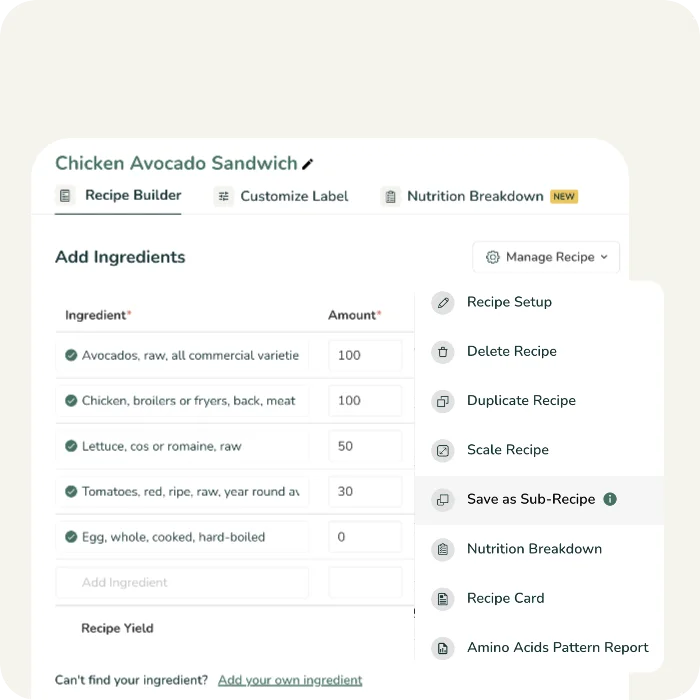
Sub-Recipe Builder
Create and save sub-recipes, and easily insert them into your main recipes with one click.
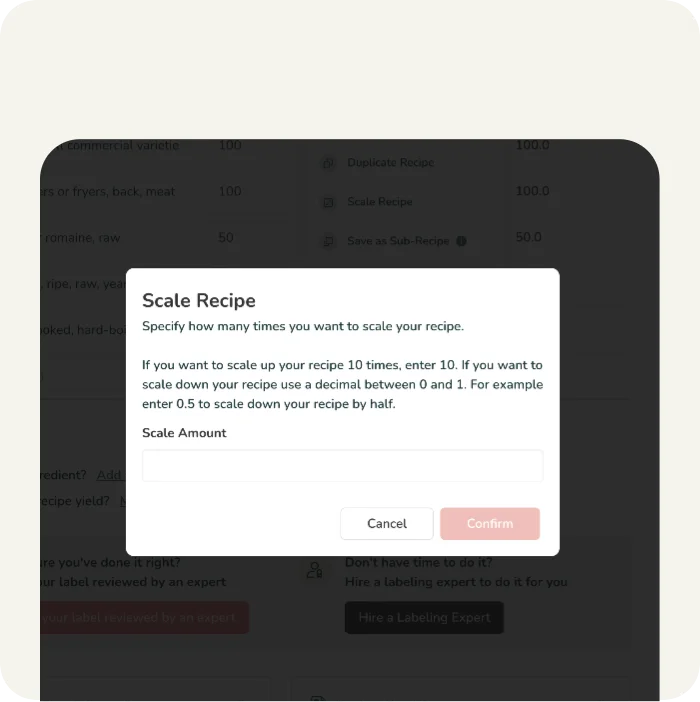
Recipe Scaling
Scale your recipe up or down by specifying the scaling factor and our tool will automatically run the calculations for you.
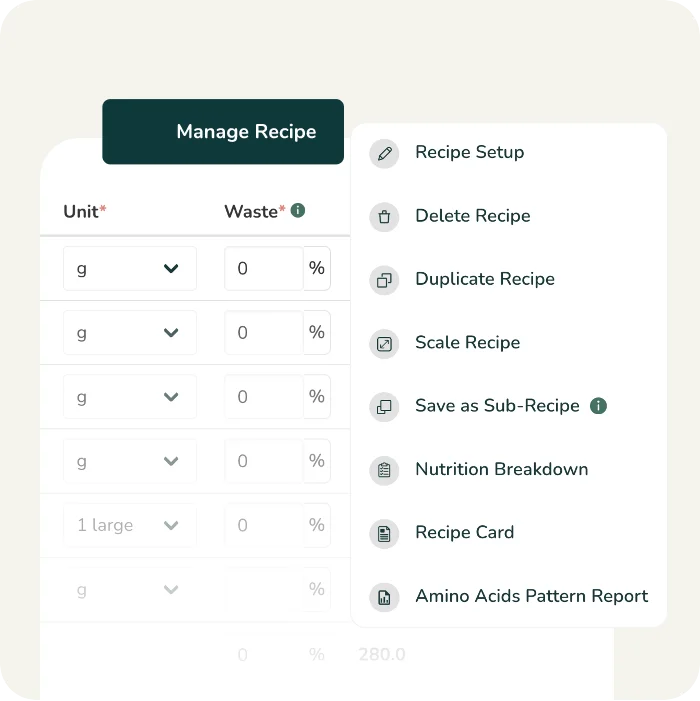
Recipe Management
Simplify recipe management through our categorization, duplication, and deletion features, facilitating efficient menu organization.

Suggested Nutrition & Marketing Claims
Our unique nutrition algorithm scans your recipe and suggests possible Nutrition & Marketing claims you can make based on the latest regulatory requirments in your market.
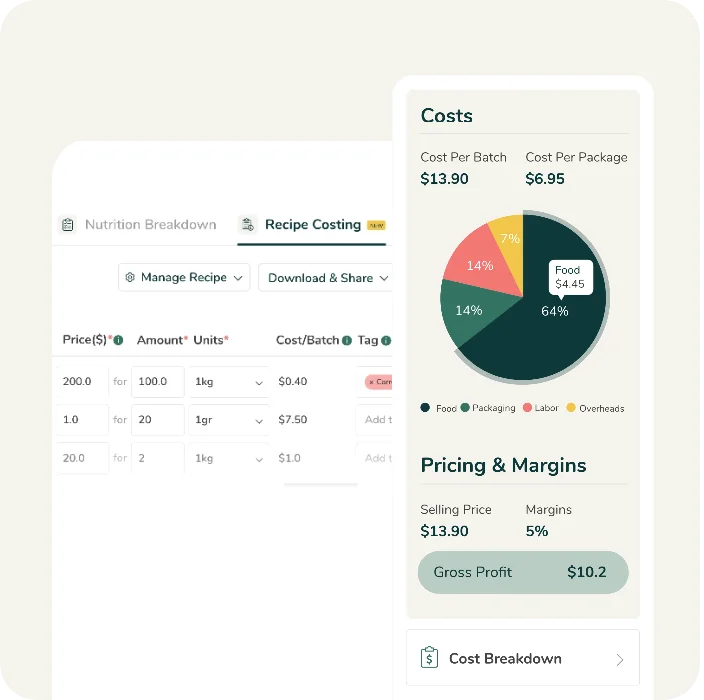
Recipe Costing
Quickly and accurately calculate your recipe costs, including ingredients, packaging, and labor costs. Determine your optimal selling price, target profit margins, and gross profit with ease.
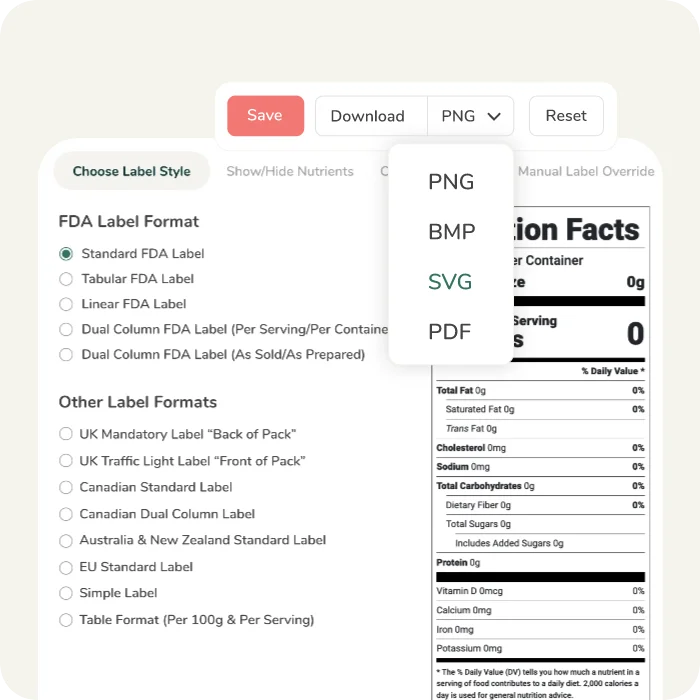
High Resolution Label Artwork exports
Download your labels in High resolution artwork files formats like PDF, Vector SVG, BNP, or PNG for packaging design.
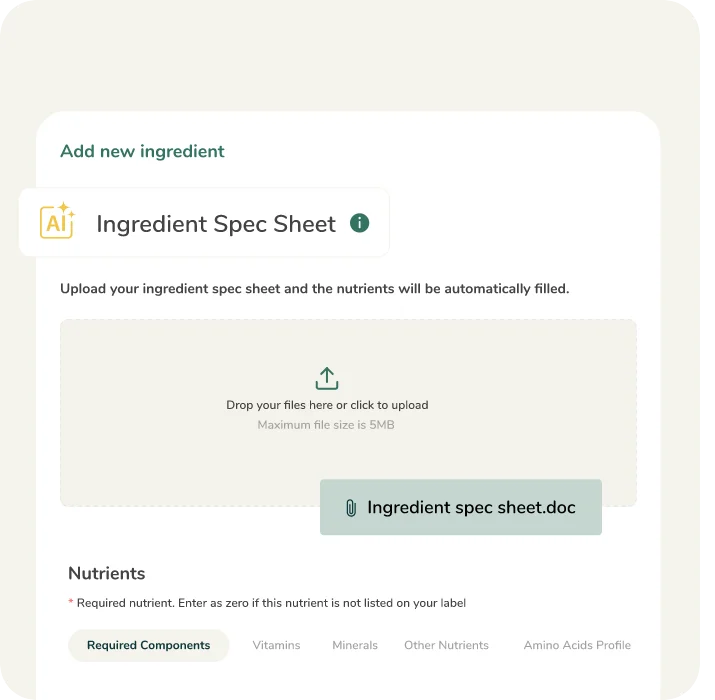
AI Enabled Spec Sheet Parsing
Simply upload your ingredient spec sheet, and our AI tool will read the nutrients and automatically fill in your custom ingredients.

Notes & Attachments
Add custom notes and various attachments like recipe cards & spec sheets to your recipes or custom ingredients.
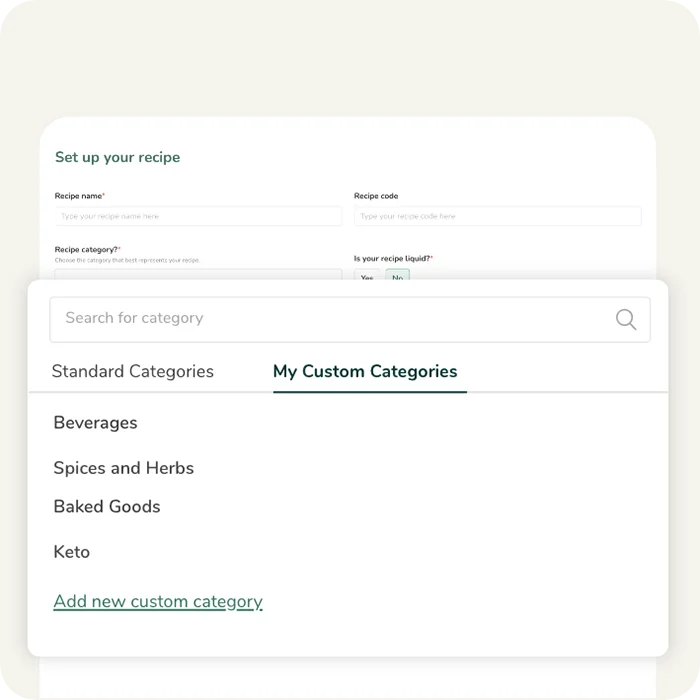
Custom Categories
Create custom categories for your ingredients and recipes.
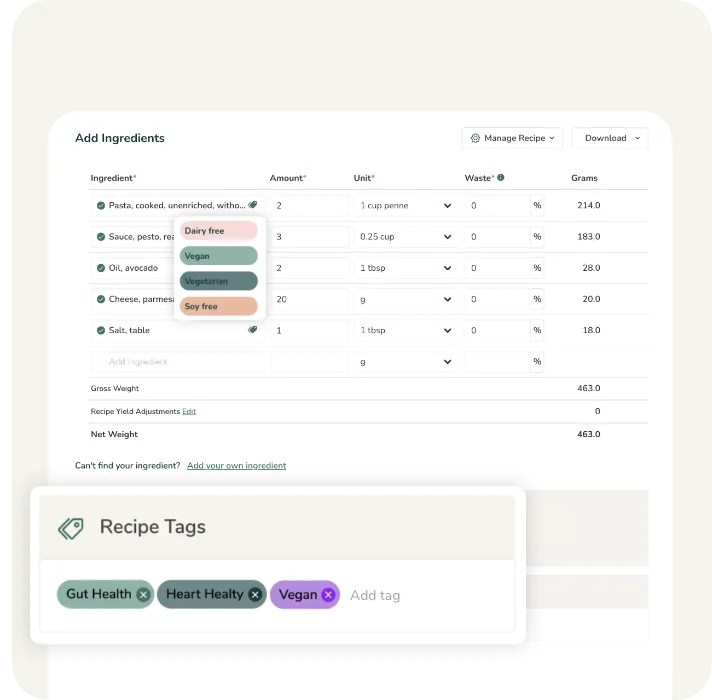
Ingredient & Recipe Tags
Effortlessly organize your ingredients and recipes with tags like Keto, Vegan, or Non-GMO, or create custom ones to suit your needs. Tags make it easy to find, sort, and manage your items efficiently.
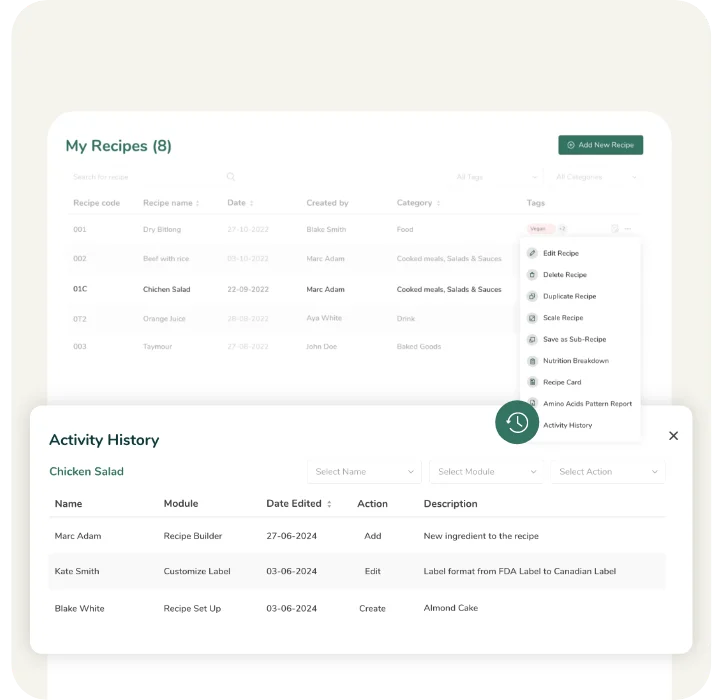
Ingredient & Recipe Activity History
Keep a detailed record of all changes made to recipes and ingredients, including who made the updates. Track revisions and modifications for better version control, compliance, and accountability.
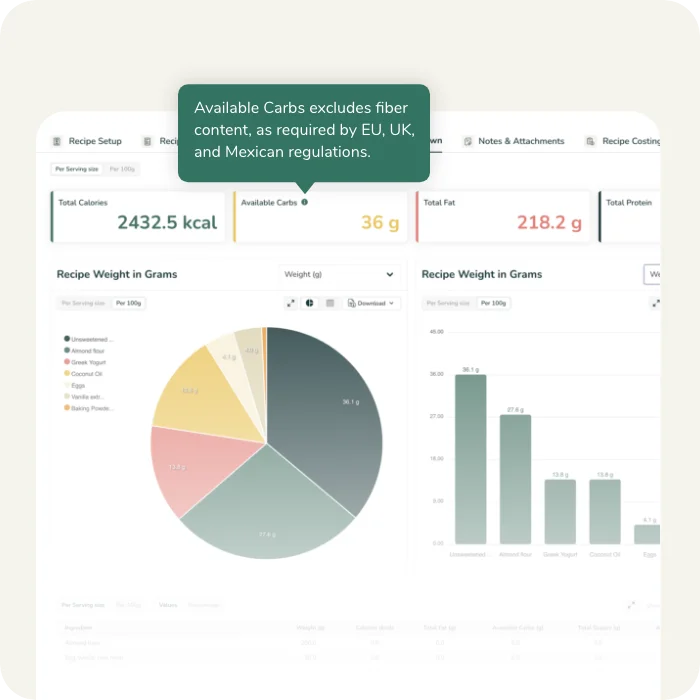
Available Carbohydrate Calculations
For EU, Mexico and UK labels FLM will automatically calculate your available carbohydrates automatically from your total carbohydrates to be shown on the label.
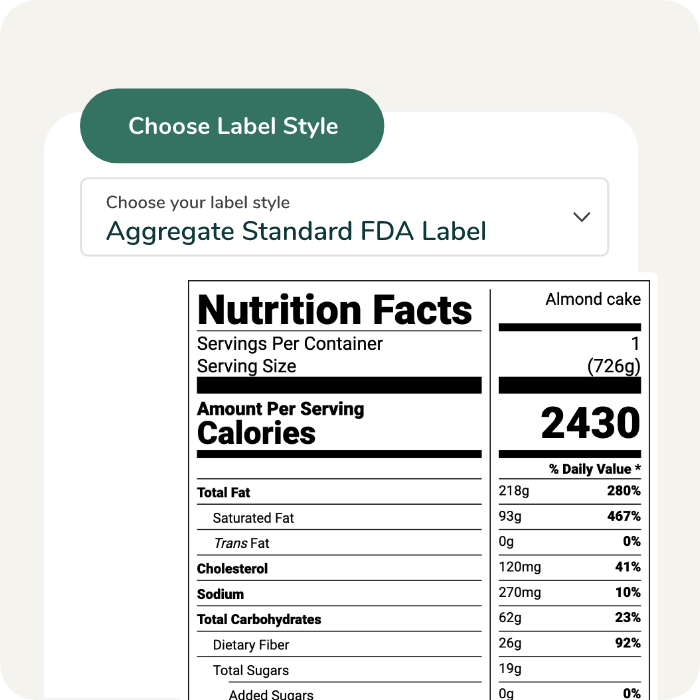
Aggregate Label Format
Implement FDA-Compliant Aggregate Nutrition Labels for multi-component products.
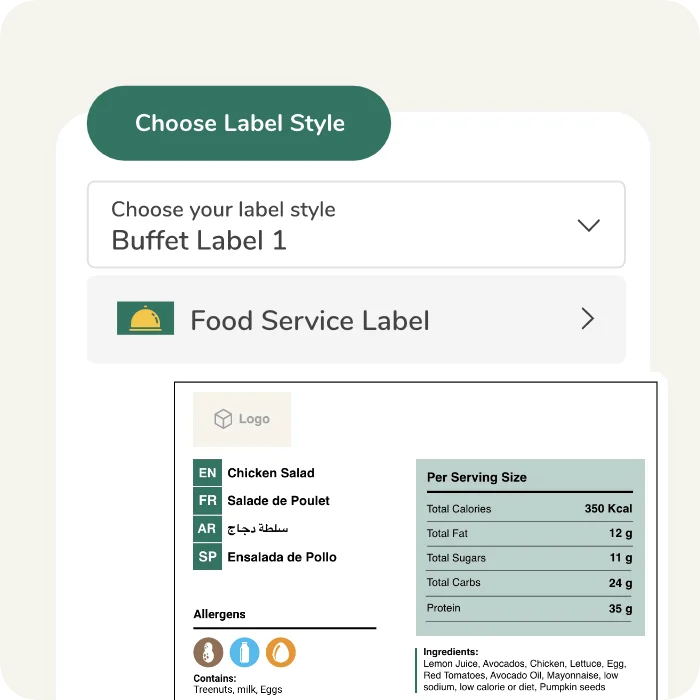
Buffet Label Format
Implement a menu-style label for your recipe with multiple language and customization options.

Calculate %DV based on rounded or unrounded nutrient values.
Enable %DV calculations using either rounded or unrounded nutrient values, offering flexibility and precision in nutrition label formatting.
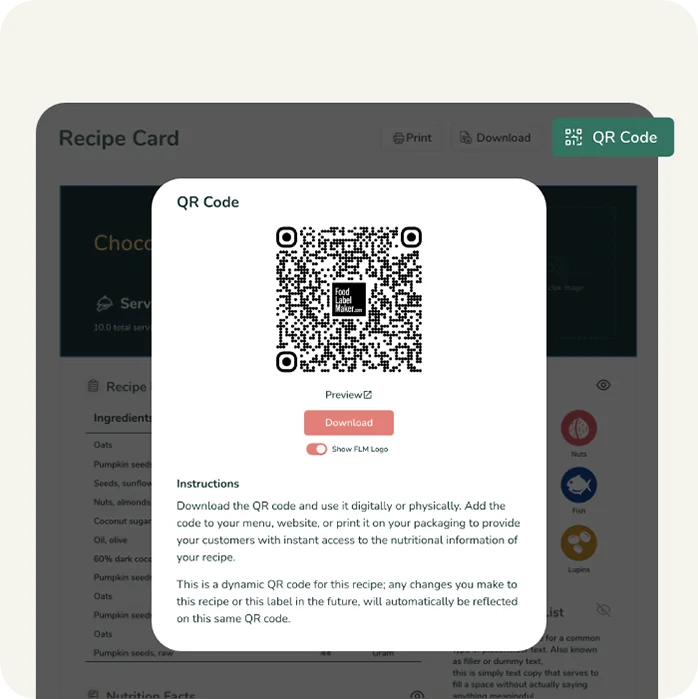
Share Your Recipe Card
You can now share your recipe card via QR code or link. You also have the option to customize the recipe card to choose what shows when you share it.
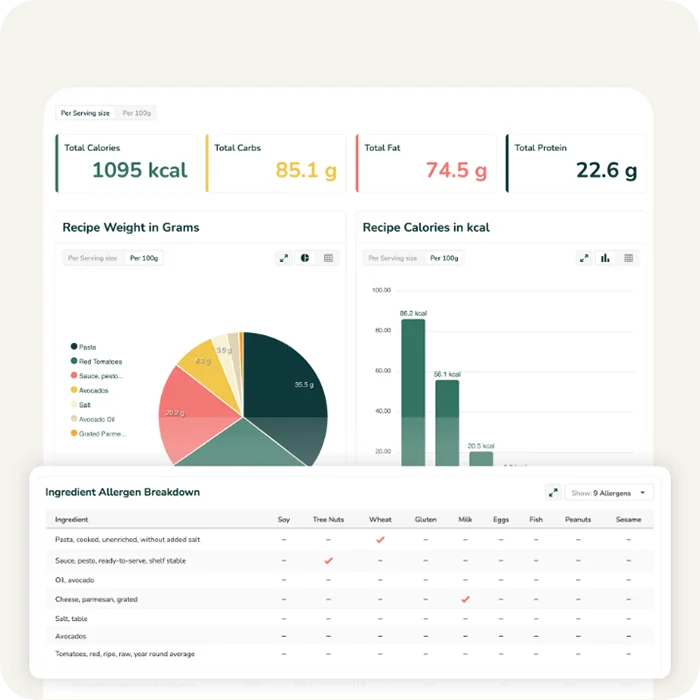
Allergen Breakdown Report
Easily track allergens in your recipes with our new Allergen Breakdown Table in your recipe’s Nutrition Breakdown Report! Now, you can view allergen presence for each ingredient, toggle allergens on or off, and download the full report.

Canadian Front Of Pack Labelling
Food Label Maker will automatically detect if your product exceeds thresholds for saturated fat, sugars, or sodium and will generate the required Health Canada warning symbol—saving you time and ensuring accuracy.
FAQ
Yes, but it’s important to ensure accuracy and adherence to specific regulatory guidelines and labeling practices. Start by gathering information about the food’s ingredients and their quantities. Also, ensure that you include standard information like serving size, calories, macronutrients (carbohydrates, fats, proteins), vitamins, and minerals. It must also be FDA-compliant and follow local labeling laws and guidelines. using software to assist you might be more helpful and will ensure that your label provides accurate and helpful information.
Yes, the Food and Drug Administration (FDA) is responsible for overseeing and regulating the accuracy of nutrition facts labels. The FDA sets specific guidelines for labeling requirements which include the format, content, and presentation of food label information. They will take necessary action if the labeling is found to be inaccurate or non-compliant with the established regulations.
- Updated Design: The new label has a larger font size for “Calories” and “Serving Size” to make them more prominent. The overall design is more streamlined and emphasizes important information.
- Added Sugars: “Added Sugars” is now included on the label to distinguish between naturally occurring sugars and those added during processing or preparation.
- Updated Daily Values: Daily Values (DV) for nutrients like sodium, dietary fiber, and vitamin D have been updated to reflect the latest scientific research.
- Changes in some nutrients required: Vitamin D and potassium are required on the label. Calcium and iron will continue to be required. Vitamins A and C are no longer required but can be included on a voluntary basis.
- Nutrient Listings: The amounts of vitamins and minerals are listed in both grams and as a percentage of the Daily Value, making it easier to understand the nutrient content.
- Dual Column Labels: Some packages that are typically consumed in one or multiple sittings have dual column labels to indicate both “per serving” and “per package” nutritional information.
These changes apply to most packaged foods, with a few exemptions being made for certain small businesses or specialized products.
Verifying Nutrition Facts involves several steps to ensure accuracy. Here’s a general process:
- Recipe Analysis: Start by analyzing the recipe or formulation for your food product. Determine the quantities and specific brands of ingredients used.
- Nutrient Calculation: Use reliable sources such as food databases or nutrition label software to calculate the nutritional content of each ingredient. Ensure accuracy by cross-referencing multiple sources.
- Serving Size Determination: Determine the appropriate serving size for your product based on how it is typically consumed. This will be the reference point for the nutritional values listed on the label.
- Accurate Measurements: Ensure precise measurements of ingredients during the manufacturing process. Use calibrated scales and measuring tools for accuracy.
- Lab Testing (Optional): For more accurate results, consider sending samples of your product to a laboratory for nutrient analysis. This can be especially useful for complex or unique products.
- Compliance with Regulations: Ensure your Nutrition Facts label adheres to local labeling laws and guidelines, such as those set by the FDA in the United States. Verify that your label includes all required information and follows the formatting guidelines.
- Consultation with Experts: Consider consulting with nutritionists, dietitians, or food labeling experts to review your Nutrition Facts label and verify its accuracy.
Remember, accurate nutrient analysis is crucial for providing reliable information to consumers, promoting transparency, and complying with regulatory requirements.
- Convenience: Nutrition Facts Label makers provide a user-friendly and efficient way to create professional-looking Nutrition Facts Labels. They often have pre-designed templates and automated calculations based on FDA regulations, making the process quicker and easier.
- Accuracy: Nutrition facts label makers are typically equipped with comprehensive databases of ingredients and heavily researched nutritional information. This helps ensure accurate calculations and eliminates the risk of manual errors.
- Compliance: Nutrition Facts Label makers are designed to adhere to FDA labeling regulations and guidelines. They can automatically generate labels that meet the required format, content, and presentation, reducing the chance of non-compliance.
- Customization: Many nutrition facts label makers allow for customization, such as adding company logos, changing fonts or colors, and adjusting label sizes. This enables businesses to create labels that align with their branding and product packaging.
- Time and Cost Savings: By automating the label creation process, label makers save time and effort compared to manually designing and calculating nutrition labels. They also help avoid potential costs associated with label errors or non-compliance.
- Professional Appearance: Label makers produce high-quality labels that look polished and consistent. This can enhance the overall presentation of your product and instill consumer trust and confidence.
However, it is important to note that while nutrition facts label makers can simplify the label creation process, it is still essential to ensure the accuracy of the information input into the software and review the generated labels for any potential errors or inconsistencies.
